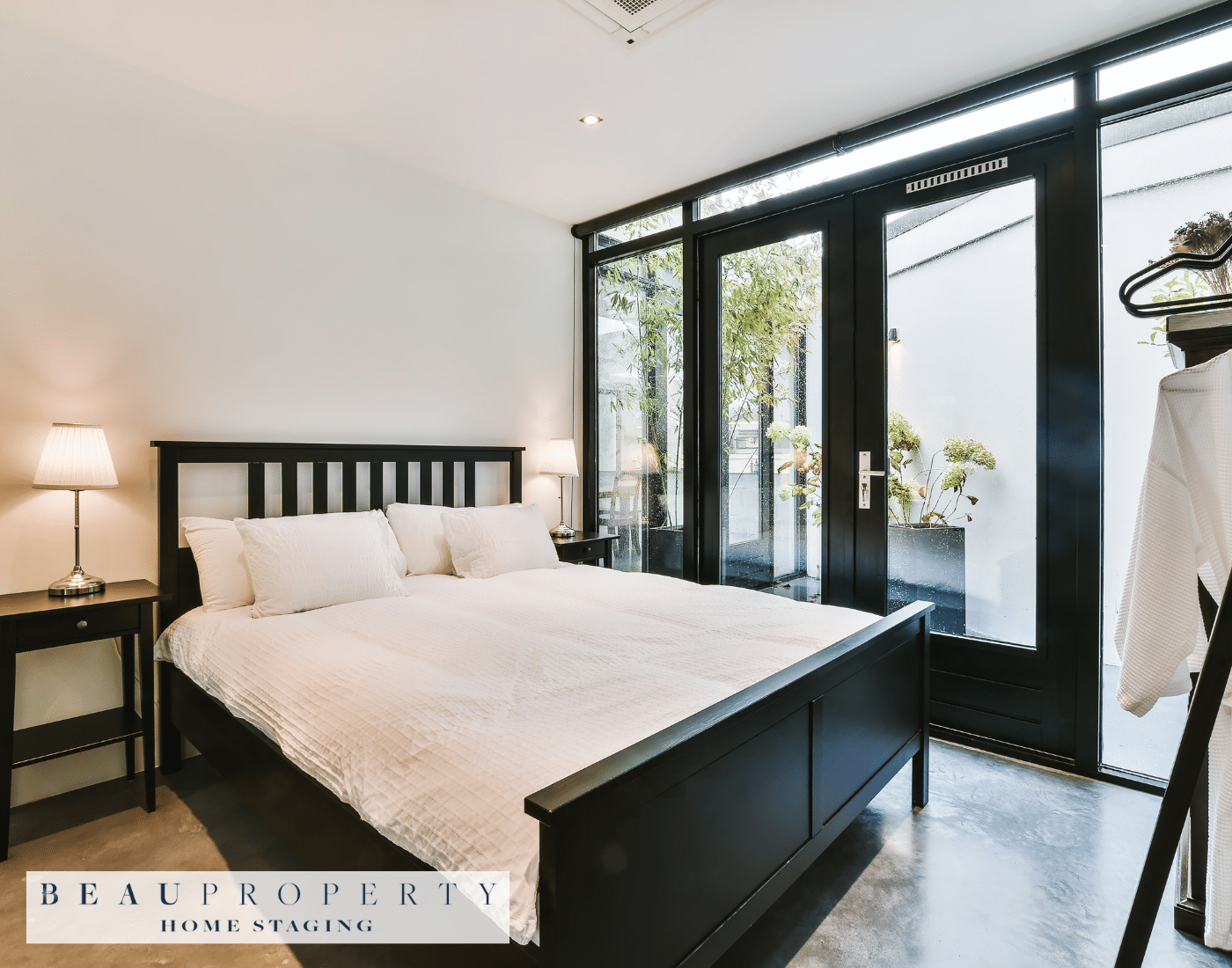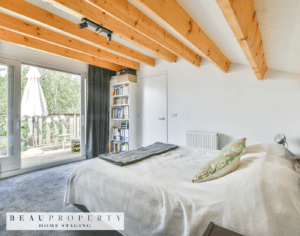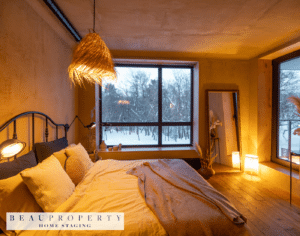Selling a home is a multifaceted process, but one of the most critical aspects is how you present the space to potential buyers. The bedroom, often considered a sanctuary, plays a pivotal role in the overall impression of a home. Staging a bedroom effectively can greatly enhance its appeal, making it easier for buyers to imagine themselves living in the space. In this blog post, we will explore various ideas and inspirations for staging a bedroom that will leave a lasting impression.
The Importance of Bedroom Staging
When selling a home, first impressions are everything. Potential buyers often make up their minds within minutes of entering a property, so it is crucial to ensure that every room, especially the bedroom, is presented in the best possible light.
Creating a Sense of Calm
A well-staged bedroom should evoke a sense of calm and relaxation. This is where potential buyers will envision themselves unwinding after a long day, so it’s essential to create an atmosphere that promotes tranquillity. Neutral colours, soft textures, and minimal clutter are key elements in achieving this effect.
Highlighting Space and Functionality
Bedrooms come in all shapes and sizes, and it’s important to highlight the space and functionality of the room. Whether it’s a small guest room or a master suite, staging should make the most of the available space, ensuring that it feels both spacious and functional.
Preparing the Bedroom for Staging
Before diving into the creative aspects of staging, there are some practical steps that need to be taken to prepare the bedroom.
Decluttering and Cleaning
The first step in staging any room is decluttering. Remove any personal items, such as family photos, trinkets, and excess furniture, to create a blank canvas. The goal is to make the room appear as spacious and clean as possible. Once decluttered, a thorough cleaning is essential. Dust, vacuum, and polish every surface to ensure the room is spotless. For more details on how professionals tackle this, you might want to explore Beau Property’s Staging Process.
Repairing and Refreshing
Next, take care of any minor repairs that may be needed. This could include fixing squeaky doors, patching up holes in the walls, or replacing a worn-out carpet. A fresh coat of paint in a neutral colour can do wonders for refreshing the room, giving it a clean and updated look.
Choosing the Right Colour Palette
Colour plays a significant role in how a room is perceived. The right colour palette can make a bedroom feel more inviting and spacious, which is crucial when staging a home for sale.
Neutral Tones for Broad Appeal
Neutral tones are the safest bet when it comes to staging a bedroom. Shades of white, beige, grey, and soft pastels tend to have broad appeal, allowing potential buyers to imagine their own furniture and décor in the space. These colours also have a calming effect, which is ideal for a bedroom setting.
Adding Subtle Pops of Colour
While neutral tones should dominate the colour palette, adding subtle pops of colour can enhance the room’s visual interest. This can be done through accessories such as cushions, throws, or artwork. The key is to keep it understated so that the room remains universally appealing.
Furniture Arrangement and Selection
The way furniture is arranged in a bedroom can significantly impact how the space is perceived. Proper furniture placement can make a room feel larger, more functional, and more inviting.
The Bed as the Focal Point
In any bedroom, the bed should be the focal point. Position the bed in a way that it’s the first thing you see when you enter the room. This creates a strong visual impact and helps to anchor the space. If the room is small, consider using a bed with a lower profile or one that has built-in storage to maximise the available space. For inspiration on how to make the bed the star of the room, check out some of Beau Property’s Portfolio of past projects.
Minimising Excess Furniture
It’s important not to overcrowd the bedroom with too much furniture. Stick to the essentials: a bed, bedside tables, and perhaps a dresser or chair. The idea is to make the room feel spacious and uncluttered. If the room is particularly small, consider removing any bulky pieces that may make the space feel cramped.
Incorporating Functional Pieces
While minimalism is key, incorporating a few functional pieces can enhance the room’s appeal. For example, a stylish bench at the foot of the bed or a reading nook with a comfortable chair and side table can add both function and charm to the space.
Enhancing the Ambiance with Lighting
Lighting is a vital element in bedroom staging. The right lighting can make a room feel warm, inviting, and cosy, which is exactly the atmosphere you want to create in a bedroom.
Layered Lighting for Depth
Consider using layered lighting to add depth and dimension to the bedroom. This can be achieved by combining ambient lighting, such as ceiling fixtures, with task lighting, like bedside lamps, and accent lighting, such as wall sconces or floor lamps. This approach not only illuminates the room effectively but also creates a more dynamic and visually interesting space.
Natural Light is Your Best Friend
Whenever possible, maximise the amount of natural light in the bedroom. Open curtains or blinds to let in as much daylight as possible. Natural light not only makes the room feel larger and more welcoming but also highlights the colours and textures in the space.
Choosing the Right Light Fixtures
When selecting light fixtures, opt for designs that are both functional and aesthetically pleasing. Simple, modern fixtures in neutral tones are usually the best choice for staging. Avoid anything too bold or personalised, as the goal is to appeal to a wide range of tastes.
Accessorising for Impact
Accessories are the finishing touches that can take a staged bedroom from good to great. However, it’s important to strike the right balance, as too many accessories can overwhelm the space.
Bedding: The Centrepiece of the Room
The bed is the largest piece of furniture in the bedroom, and as such, the bedding plays a crucial role in the overall aesthetic. Opt for high-quality, neutral-coloured bedding with a few accent pillows or a throw blanket to add texture and interest. The bedding should look inviting and luxurious, helping potential buyers to picture themselves relaxing in the space.
Artwork and Wall Décor
Artwork and wall décor can add personality to the bedroom without being too specific or personal. Choose pieces that complement the colour scheme and style of the room. Abstract art, nature scenes, or simple black-and-white photography are good options. Be mindful not to overcrowd the walls; one or two well-placed pieces are usually sufficient.
Greenery and Fresh Flowers
Adding a touch of nature to the bedroom can enhance its appeal. A small potted plant or a vase of fresh flowers can bring life and colour to the space. Choose low-maintenance plants that thrive indoors, such as succulents or peace lilies, as these are easy to care for and don’t require much attention.
Mirrors for Added Light and Space
Mirrors are a fantastic tool for making a small bedroom feel larger and brighter. Placing a large mirror opposite a window can reflect natural light and make the room feel more open. Additionally, mirrors can serve as decorative elements that add elegance to the space.
Final Touches: Scent and Sound
While the visual aspect of staging is crucial, don’t overlook the importance of the other senses. Scent and sound can greatly influence how a potential buyer feels when they enter the bedroom.
Creating a Pleasant Fragrance
A fresh, clean scent can make a big difference in how a bedroom is perceived. Avoid overpowering fragrances; instead, opt for subtle, natural scents like lavender or vanilla. Candles, reed diffusers, or a lightly scented room spray can all be effective ways to introduce a pleasant aroma into the room.
Using Soft Background Music
Playing soft, calming background music during showings can create a soothing atmosphere. Classical music, instrumental pieces, or nature sounds are all good choices. The music should be low enough that it doesn’t distract but just loud enough to add to the overall ambiance.
Common Mistakes to Avoid
While staging a bedroom, there are some common mistakes that sellers should be mindful of. Avoiding these pitfalls can help ensure that the bedroom makes the best possible impression.
Over-personalisation
One of the biggest mistakes in staging is leaving too many personal items in the room. Potential buyers need to be able to see themselves in the space, and personal items like family photos, monogrammed towels, or specific décor styles can make it harder for them to do so.
Neglecting Small Details
Small details can make a big difference in the overall impression of the bedroom. Things like wrinkled bedding, dusty surfaces, or a cluttered bedside table can detract from the room’s appeal. Pay attention to these details to ensure that the room looks polished and well-maintained. For more tips on avoiding common pitfalls, Beau Property’s Blog Section offers a wealth of information.
Ignoring the Closet
The closet is an extension of the bedroom, and it should not be overlooked during the staging process. A cluttered or overstuffed closet can make it seem like there isn’t enough storage space in the home. Clear out the closet as much as possible, leaving only a few items neatly organised. If necessary, consider investing in some matching hangers or storage bins to create a uniform look.
Conclusion: Making the Bedroom Irresistible
Staging a bedroom for sale is all about creating a space that appeals to potential buyers on a sensory and emotional level. By focusing on creating a calm, inviting atmosphere, highlighting the room’s space and functionality, and paying attention to the finer details, you can transform the bedroom into one of the most attractive features of your home. Remember that the goal is to help buyers imagine themselves living in the space, so keep things neutral, clean, and welcoming. With these ideas and inspirations, you’re well on your way to staging a bedroom that will make a lasting impression.






